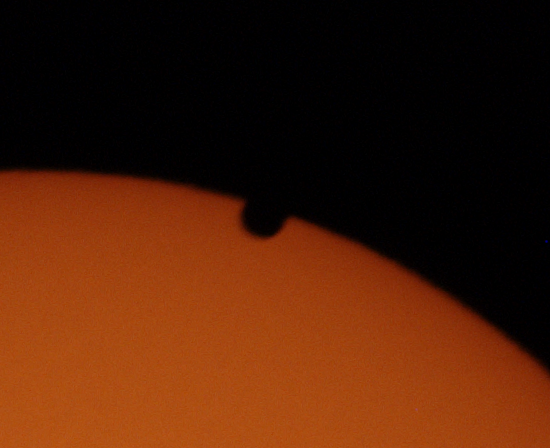 | |
| Saturn 2012-06-16, CSSC 20" refractor (rachael) |
This particular day, the seeing wasn't perfect. That is, although it was perfectly clear and the image nice and bright, the image jumped around and distorted a lot, so that leads to motion blur. I tried to keep the exposures short; I tried 1/6 second and 1/15 second speed, and stacked the best images; but even so, this is what I get. That's my excuse for the image above looking just a little bit out of focus. But that said, the results are pretty good, and there are some interesting details.
First of all, you can see some bands across the main disk of the planet. They run around the planet, and follow the "trade winds" that encircle the planet at high altitudes. Saturn's colors are not as dramatic as Jupiter's, so the bands are not as dramatic, but they are there, and the causes are pretty much the same.
Of course, everybody thinks about those rings when thinking about Saturn. The most obvious feature is a gap called the Cassini Division, so named because it was discovered by Giovanni Cassini in 1675. The division, and other fainter divisions, look like grooves on an (old fashioned) vinyl record and separate the disk that would otherwise be a single ring into several rings. We know from spacecraft that have visited Saturn that the gaps are created by tiny moons that clear out the space between the rings and shepherd the rings into bands the that we see.
If you look carefully, you can also see to the left and behind the planet a gap across the rings. That is the shadow of the main planet cast across the rings. (The Sun is behind our back and to the right.) And if you look real close, along the bottom edge of the ring, where the ring passes in front of the planet, you can see a narrow dark line that is a shadow cast by the rings onto the body of the planet. All that gives you a sense of perspective, doesn't it?
This is just about the same view you would have seen if you were with us looking directly through the telescope. In fact, with your eyes, you would have been able to see some of Saturn's moons, too, but the moons didn't make it into this picture. The camera doesn't have the dynamic range that your eyes have, so the moons were either too faint to be seen by the sensor, or washed out by Saturn's glare. Oh well. In another session, I might try to get a shot of the moons. I'll have to think about how to do that.



